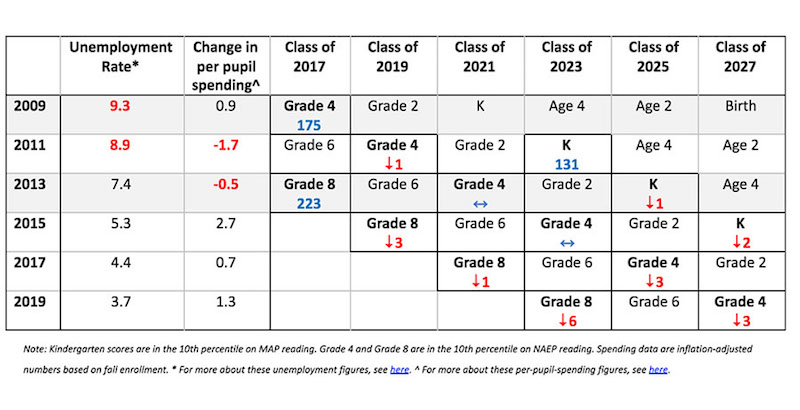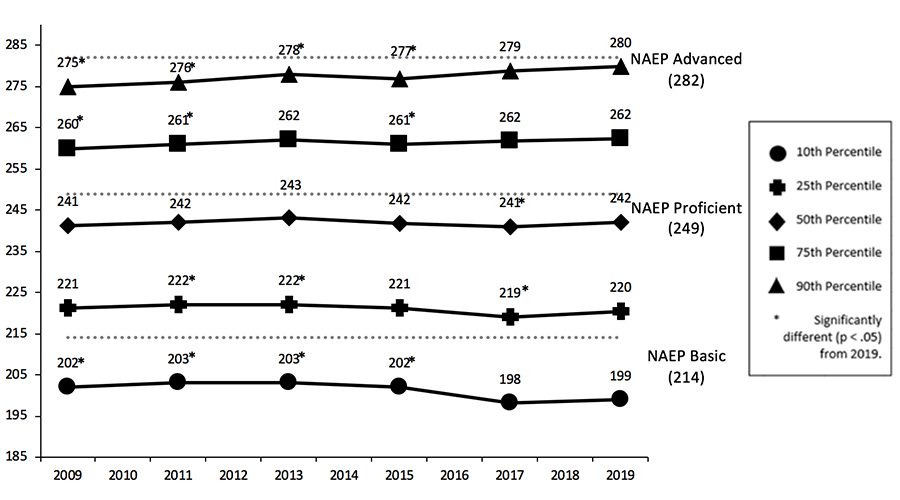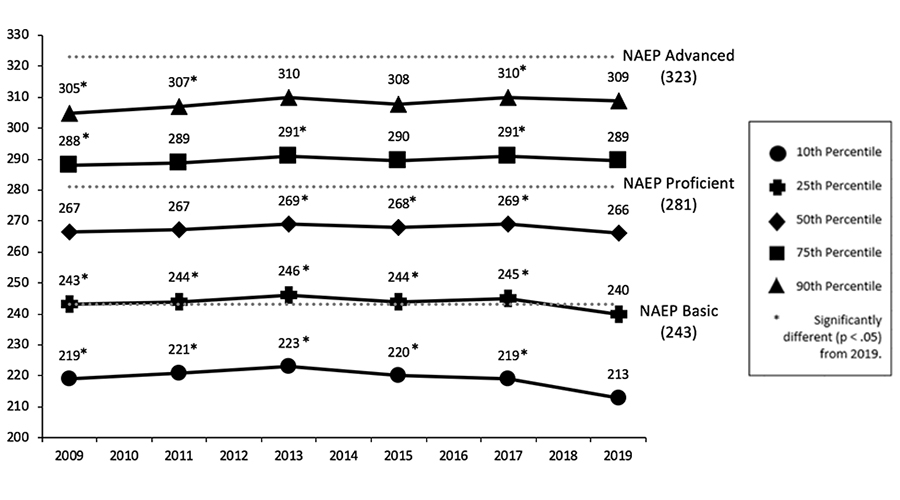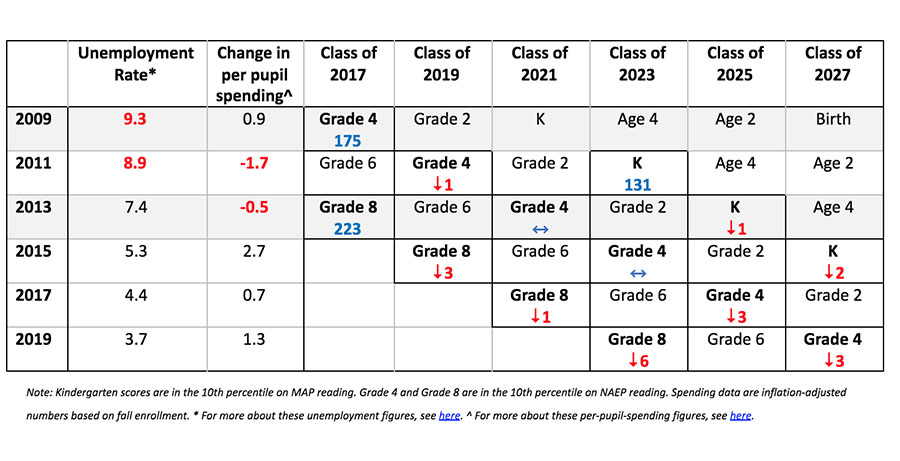Petrilli: 2019 NAEP Results Show There’s Something Wrong Going On. 3 Theories About What Might Be Happening in Our Schools, and Beyond

Updated Nov. 21
The New York Times headline pointed to “decline.” Politico used the word “slump.” And the Associated Press went with “lags.” Any way you say it, the latest scores from the Nation’s Report Card were bad, with trends getting worse over time. In particular, America’s lowest-performing students, who also tend to be our lowest-income children, are faring particularly poorly, especially in eighth grade, and especially in reading, but pretty much all across the board. The bad news also goes beyond just traditional public school kids; it’s happening in the private school sector, too, as Nat Malkus of the American Enterprise Institute points out. And equally worrying are recent data showing declines in kindergarten readiness skills from 2013 to 2017.
Fourth-Grade Math Scale Scores by Percentile, 2009-2019

Eighth-Grade Reading Scale Scores by Percentile, 2009-2019

Meanwhile, our higher-achieving students are mostly holding steady or even making gains — cause for celebration, to be sure, but also a clue as to what might be happening in schools and beyond.
What might explain all this? It’s impossible to tell from the data made available by the National Assessment of Educational Progress (NAEP); that test, as good as it is, doesn’t allow analysts to examine individual student performance over time, which is required for gold-standard research. Still, we can look at other trends in our schools and society to determine which ones may best fit the fact pattern we’re seeing on NAEP. Let me dig into three hypotheses:
1. It’s the economy, stupid. The devastating and lingering effects of the Great Recession on fragile families, and on school spending, are largely to blame.
2. It’s the pixels. Screen time is distracting kids and their parents, especially in families without the money for nannies and structured activities, and is leading to problems with attention and learning.
3. It’s our shift in attention away from basic skills. Over the past 10 years, schools nationwide have been working on helping students reach higher standards — but perhaps they’ve taken their eye off the ball when it comes to kids struggling with lower levels of literacy and numeracy.
The Great Recession was terrible for families and schools
As I’ve argued in previous posts and comments to the media, there are at least two ways the recession might have dampened scores: first, via its devastating impact on fragile families and their young children; and second, through its negative impact on school spending, as many state coffers ran dry.
As to the first mechanism, I argued this summer that big shifts in the economy — both booms and busts — appear related to the subsequent academic achievements of babies and toddlers who live through those changes, especially poor children and particularly those at the low end of the performance spectrum. Most notably, the roaring ’90s led to a huge decrease in “supplemental” child poverty rates — which take into account all government taxes and transfers — especially for kids of color. And that could explain much of the NAEP gains we saw in the 2000s, gains that were most dramatic for low-performing children and kids of color.
So it would make sense that the Great Recession and its awful, long-lasting effects (with unemployment rates above 8 percent from 2009 to 2012) would have an equal and opposite impact on vulnerable children and their families. With parents jobless, stressed out and struggling to make ends meet, it’s not hard to imagine that little ones would get less care and attention in all the ways that we know matter to their cognitive and social development.
Another way the recession could negatively impact children is its effect on school spending. Two years ago, economist Kirabo Jackson laid out the case that the big spending cuts of 2011-13 — the first significant year-over-year declines in K-12 expenditures in American history — were related to depressed achievement, at least in math. Perhaps this need not have been the case, had districts used the tough times to stretch the school dollar in smart ways by, for example, removing ineffective teachers from classrooms when forced to make cuts. But instead, they generally laid off the most junior teachers, froze salaries, raised class sizes and stopped purchasing curricular materials. Not a formula for improved achievement! Furthermore, if young students didn’t get what they needed in the critical early years (say, kindergarten through third grade), they might lag for their entire educational careers.
If we follow cohorts of students from birth through their educational careers, and look at how old they were when the recession struck and when the spending cuts took hold, we can start to examine whether the facts fit the Great Recession story. My read is that the hypothesis largely checks out.

I find it especially compelling that national fourth-grade scores for the lowest-performing kids started to decline significantly only with the cohorts born during the high-unemployment years of 2009 to 2012. Furthermore, eighth-grade scores started to decline only with the cohorts that were in grades K to 3 during the big spending declines of 2010 to 2013. And the eighth-graders who took the NAEP last spring faced the double whammy of being toddlers during the recession and elementary students during the age of austerity. So it makes sense that their scores are down so markedly.
When we explore state-by-state scores, however, we are faced with a conundrum: Scores are down almost everywhere, including states that the Great Recession passed by. Consider North Dakota and Alaska, for instance.
With their vast oil reserves and other natural resources, they escaped the recession almost unscathed. Unemployment in Alaska grew less than 2 percent; in North Dakota, less than 1 percent. Both states also increased their per-pupil spending during the leanest years. Yet in both cases, achievement of their lowest-performing students is down across the board, in grades four and eight, in reading and in math.
The New England states of New Hampshire and Vermont also made it through the recession OK, yet they saw declines almost across the board, too.
So perhaps the Great Recession largely explains the national trends we’re seeing, but not entirely. What else is happening — including in rural America — that could have put achievement in reverse for our lowest-performing, and generally neediest, kids?
Let’s all scream about screens
If you ask the proverbial man on the street why test scores are down, especially in reading, he might well point to the ubiquitous (and ironically named) smartphone. It causes anxiety! It keeps kids from books! It distracts Mom and Dad, too!
All this may be true, but there’s little evidence that children in general actually spend more time on screens than before. Only the technology has changed; now it’s YouTube and TikTok instead of TV and Atari.
Yet low-income children tend to watch TV and play video games more than their affluent peers, and that may (in part) explain why they do worse academically. As The 74 reported two years ago, “Children from lower-income families spend an average of three and a half hours each day on screen media, according to a nationwide survey conducted by the nonprofit Common Sense Media. That amount is 40 percent longer than middle-income children (two hours and 25 minutes) and almost double the screen time spent by affluent children (one hour and 50 minutes).”
But tucked inside that survey was another important clue: Screen time for low-income kids has absolutely skyrocketed in recent years.

If other surveys confirm that these trends are real and durable, screen time surely deserves to be fingered as one culprit for recent declines among low-performing and low-income students. Yet it doesn’t explain why we’re seeing some improvements for students at the top of the performance spectrum, given that their screen time trends are flat. For that, we must keep looking.
From No Child Left Behind behind
Finally, we should of course consider what’s been going on inside our schools, especially if we want to understand why we’re seeing the achievement gap grow between high- and low-performing students. One possibility is that our shift to higher standards is having unintended consequences for our lowest-performing kids.
Let’s recall that No Child Left Behind was focused obsessively on the nation’s lowest-achieving students, with its goal of getting all students to basic levels of literacy and numeracy. Back then, neither the standards in place in most states nor the assessments were very challenging. Nothing in the accountability model incentivized the progress of kids who had already mastered low-level standards. But studies would eventually show that the strategy worked: The performance of the lowest-performing students rose dramatically from the 1990s into and through the 2000s. Afterward, those kids were achieving two to three grade levels ahead of their earlier counterparts — historic, life-changing progress. (As mentioned above, the booming 1990s economy, and big spending increases into the 2000s, were likely at least partly responsible for this good news.)
With the Nation’s Report Card showing students making gains, and with George W. Bush still in the White House, support for accountability remained relatively strong for the first half of the 2000s. But as the decade wore on, NCLB and related policies attracted more criticism and derision. The problems of testing and accountability were becoming all too clear. Among them: Many schools were spending myriad hours on low-level test prep, and the “one snapshot in time” approach to measuring school effectiveness was discouraging schools from paying attention to everyone but the “bubble kids” performing near the line demarcating “proficiency” in reading and math. Perhaps most significantly, the low-level standards and tests in place in most states were said to be sending the wrong signal to parents, educators and taxpayers: that vastly more students were on track for future success than really were. It was the illusion of proficiency.
With many fits and starts, these concerns eventually paved the way for what I’ve called Accountability 2.0. This recalibration included much more demanding academic standards that were aligned to readiness for college and career, conspicuously in the form of the Common Core; much higher-quality and more rigorous assessments, in the form of Smarter Balanced and PARCC and their successors; and much fairer accountability systems with a greater focus on student progress over time.
So given the improvements for our highest-achieving students, perhaps the shift to loftier academic standards, tougher tests and accountability systems that encourage paying attention to everybody’s progress is working, at least for the kids at the top of the class. Maybe more of them are gaining access to instruction that’s actually and appropriately challenging. If so, that’s worth celebrating — but it means we need to double down on our efforts to identify ways to help their lower-achieving peers benefit from the higher expectations, as well. At the least, that means building instructional resources that can help kids who are well below grade level catch up. We might need to try even more radical solutions, like adding one more grade level to schools with lots of low-performing kids.
We won’t ever have perfect information about why we’re seeing such big declines on national assessments; it’s impossible for researchers to randomly assign the effects of the Great Recession on particular families or schools, or to create an experiment whereby some kids spend way more time on screens, over the course of many years, than is likely good for their cognitive development.
So we have to do the best we can with the data we’ve got. For those of us who work in or around schools, that means doing much more to help our low-performing students succeed, before the negative trends get any worse.
Michael J. Petrilli is president of the Thomas B. Fordham Institute and a distinguished senior fellow at the Education Commission of the States.
Get stories like these delivered straight to your inbox. Sign up for The 74 Newsletter

;)
